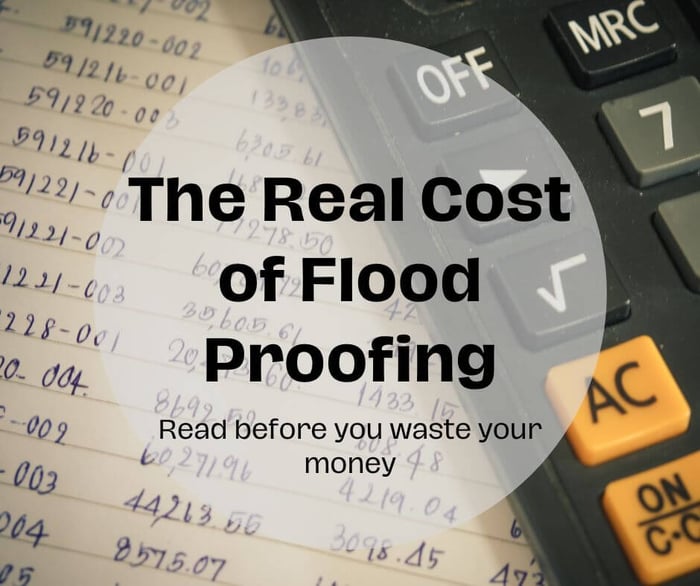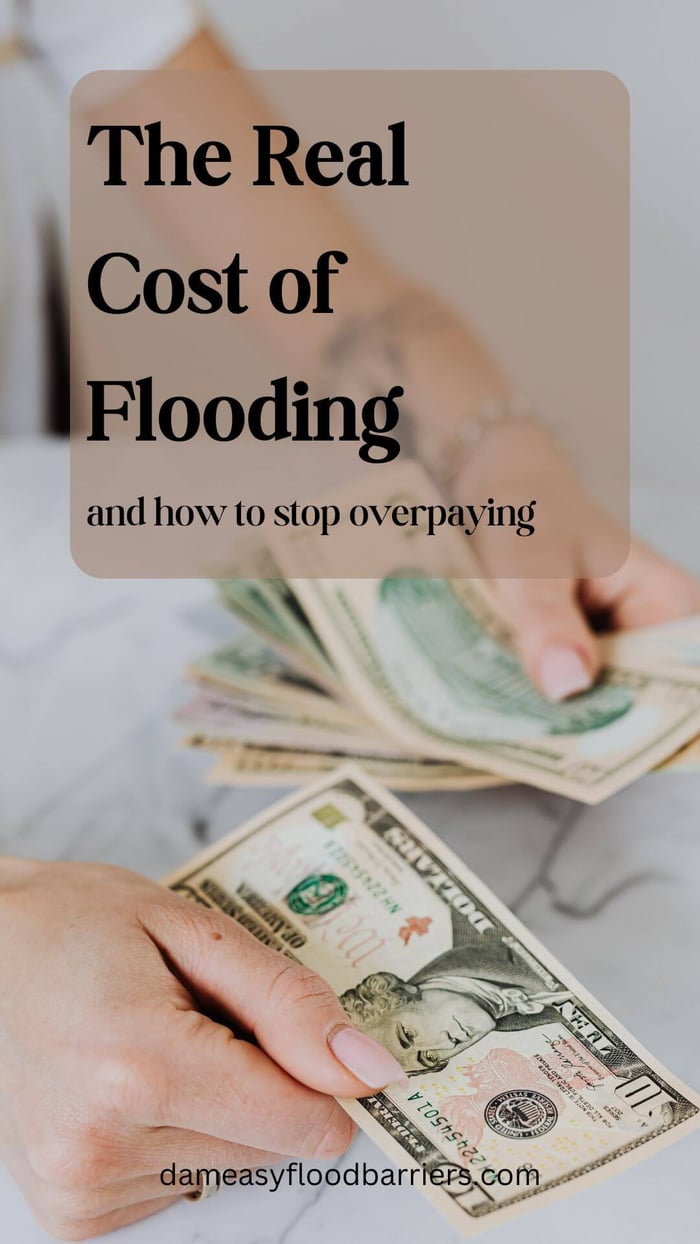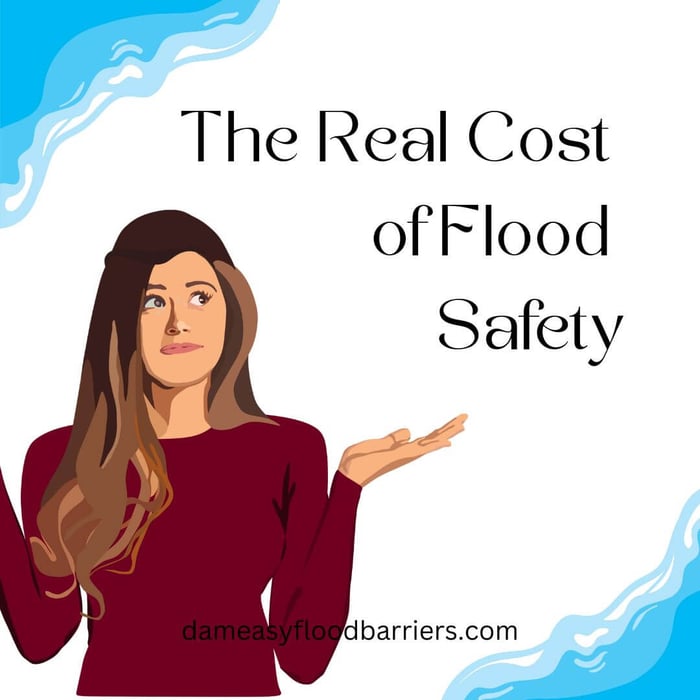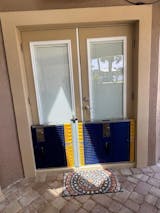Table of Contents
- Data from The National Flood Insurance Program (NFIP) and FEMA
-
- Why Floodproofing is Smarter than Repairing
- Flood Barriers: A Simple Solution to a Costly Problem
- Factors Influencing the Cost of Flood Damage
-
- Breaking Down the Costs: Direct and Indirect
- Hidden Costs of Not Floodproofing
- Steps to Reduce Flooding Costs
Flooding is one of the most common and devastating natural disasters in the United States. Whether it’s due to a storm surge, flash flood, heavy rain, or rising river levels, water damage can wreak havoc on homes. For homeowners, the cost of flooding can be overwhelming, especially since many aren’t adequately insured or prepared for such events.
But what does an average flooding event cost an average American homeowner? This article will break down the financial burden, examine both direct and indirect costs, and the factors influencing these expenses, and emphasize why floodproofing is a smarter investment than repeatedly dealing with flood damage.
Data from The National Flood Insurance Program (NFIP) and FEMA
Before diving into the numbers, it’s important to look at what government data tells us. According to the Federal Emergency Management Agency (FEMA), flooding is the most frequent natural disaster in the U.S., causing billions of dollars in damage annually. Based on FEMA's analysis:
- One inch of water can cause up to $25,000 in damages to a home.
- The average flood claim under the National Flood Insurance Program (NFIP) from 2016 to 2020 was $52,000.
- FEMA’s “Cost of Flooding” calculator reveals that even minor floods can have major financial impacts.
While these figures are averages and can give a sense of the national scope, it’s important to consider the many factors that contribute to how much any individual homeowner will need to spend after a flood.
Why Floodproofing is Smarter than Repairing
Many homeowners don’t realize that one-time investments in floodproofing solutions, such as flood barriers or other water-resistant infrastructure, can save tens of thousands of dollars over time. Rather than being reactive and paying for flood damage after every heavy rain or storm, floodproofing offers long-term protection and peace of mind.
Here are several reasons why floodproofing your home is better than repeatedly dealing with water damage:
- It’s a one-time investment: Flood barriers, flood doors, and other protective measures are installed once but can last for decades, protecting your home every time there’s a flood threat.
- Lower insurance premiums: Many flood insurance providers offer discounts for homes that are equipped with floodproofing measures, as they are less likely to experience significant damage.
- Protects your home’s value: Homes that flood frequently lose value over time. By installing flood barriers, you not only protect your home from flood damage but also maintain its market value.
- Avoids recurring repair costs: Water damage from floods can lead to costly repairs, including structural fixes, mold remediation, and the replacement of personal belongings. Floodproofing significantly reduces these risks and the associated repair bills.
Flood Barriers: A Simple Solution to a Costly Problem
Investing in flood barriers is a cost-effective solution for homeowners in flood-prone areas. Barriers such as the Dam Easy Flood Barriers create a watertight seal around doors and entryways, preventing floodwaters from entering the home.
One-time investments like these often cost significantly less than the price of a single flood damage repair. For example, purchasing flood barriers for your home might cost a few thousand dollars initially, but this is minimal compared to the potential costs of multiple repairs over several years, especially when floods are frequent.
Consider that:
- Without floodproofing, the average cost of flood damage for one event is around $20,000 to $50,000.
- With flood barriers in place, the cost of repairs after minor flooding could be reduced to a minimum or even nothing at all.
By proactively preparing your home with floodproofing measures, you’re making a long-term investment that can save you from the financial and emotional toll of repeated flood damage.
Factors Influencing the Cost of Flood Damage
The actual cost of flood damage to an individual homeowner can vary widely based on several factors:
- Location: Flood-prone areas, such as coastal regions, floodplains, and areas near rivers, are more susceptible to severe flooding. Homeowners in these regions are likely to experience higher repair costs due to more frequent and intense flooding.
- Severity of the Flood: The amount of water and how long it lingers in a home are major determinants of cost. A few inches of water can be costly, but if floodwaters rise several feet, the damage can be catastrophic.
- Home Size and Value: The cost of repairs is often tied to the size and value of the home. Larger, more expensive homes will naturally require more money to restore to pre-flood conditions.
- Type of Materials Used: Homes with high-end finishes, such as hardwood floors, custom cabinetry, and luxury appliances, will incur higher repair costs compared to homes with standard or budget finishes.
- Presence of Flood Insurance: Many homeowners mistakenly believe that their standard homeowners' insurance policy covers flood damage. In reality, flood damage is typically excluded from standard policies, and homeowners need a separate flood insurance policy. Without insurance, the full financial burden falls on the homeowner.
- Immediate Response: The sooner a homeowner can start the cleanup and drying process, the less likely mold and further structural damage will occur. A delayed response can greatly increase the cost.
Breaking Down the Costs: Direct and Indirect
Flooding costs can be divided into two categories: direct and indirect costs.
Direct Costs
These are the immediate, out-of-pocket expenses that homeowners face as a result of flood damage. Some of the primary direct costs include:
- Repairing structural damage: This includes fixing walls, floors, roofs, and foundations that have been compromised by water. Depending on the extent of the damage, repairs can range from minor touch-ups to complete reconstruction. On average, this cost ranges from $5,000 to $10,000 for minor floods and can reach well over $50,000 for severe flooding.
- Replacing damaged personal property: Furniture, electronics, appliances, and clothing can be completely ruined by floodwaters. The average homeowner can expect to spend anywhere from $10,000 to $30,000 replacing these items, depending on the value of the contents and how much was damaged.
- Water extraction and drying: Professional water extraction services are typically needed to remove standing water and dry out the home to prevent further damage and mold growth. The cost of these services can range from $2,000 to $10,000, depending on the severity of the flooding.
- Mold remediation: If water lingers in the home for too long, mold can grow, leading to health hazards and additional repair costs. Mold remediation typically costs $500 to $6,000, but if mold spreads throughout the home, the price can skyrocket to $30,000 or more.
- Electrical and plumbing repairs: Water can cause serious damage to a home’s electrical and plumbing systems. Repairing or replacing electrical wiring, outlets, appliances, and plumbing fixtures can add $2,000 to $5,000 or more to the overall cost.
Indirect Costs
These are the additional costs that aren’t as immediately obvious but still add up over time. Some examples include:
- Temporary housing: If a home is uninhabitable after a flood, homeowners may need to stay in a hotel or rent temporary housing. Depending on the location and the duration of the displacement, this can add several thousand dollars to the overall cost.
- Loss of home value: Homes that have been flooded often lose value, particularly if they’re in areas prone to repeat flooding. Even after repairs, some homeowners find that their property is worth significantly less than it was before the flood.
- Increased insurance premiums: After filing a flood claim, some homeowners may see their flood insurance premiums rise. While flood insurance premiums are regulated by the NFIP, private flood insurance policies may increase in cost after a claim is made.
- Missed work and lost income: Many homeowners need to take time off work to deal with flood repairs and insurance claims, leading to a loss of income.
Hidden Costs of Not Floodproofing
Floodproofing your home is a proactive investment that can save you from significant hidden costs in the long run. Many homeowners make the mistake of relying on flood insurance as a safety net, but even with insurance, there are significant financial and emotional tolls to consider.
One of the biggest hidden costs of not floodproofing is the increased flood insurance premiums that often follow after filing a claim for water damage. After a homeowner makes a flood insurance claim, insurers are likely to increase premiums, especially if the property is in a high-risk area or experiences repeated flooding. While flood insurance is critical, the costs can quickly add up. Here's why:
- Rising premiums: After a single flood claim, homeowners may see their premiums increase by 10% to 20%. If your home is at risk for future flooding, the premiums may continue to rise, making insurance a costly long-term expense.
- Deductibles: Flood insurance policies come with deductibles, which homeowners must pay out of pocket before the insurance coverage kicks in. Deductibles can range from $1,000 to $5,000 or more, depending on the policy, adding another layer of cost each time a flood occurs.
- Policy limits: Flood insurance policies through the National Flood Insurance Program (NFIP) typically cover up to $250,000 for structural damage and $100,000 for personal belongings. If your home sustains damage beyond those amounts, you’re responsible for covering the difference.
- Frequent repairs and ongoing risks: Without floodproofing, homeowners face ongoing exposure to water damage. Floods don’t just cause damage once; they can cause damage repeatedly. This means ongoing repairs, rising insurance premiums, and the emotional stress of dealing with the aftermath of floods year after year.
Floodproofing your home with flood barriers or other protective measures not only reduces the likelihood of needing to file a claim but also protects you from these hidden and recurring costs. While flood insurance is important, it’s a reactive solution. Floodproofing is proactive, significantly reducing both short-term and long-term expenses.
By investing in floodproofing, homeowners can prevent flood damage, keep insurance premiums low, and avoid the repetitive cycle of repairs and rising costs.
For more information on floodproofing solutions like Dam Easy flood barriers, which can protect your home from water damage and keep insurance premiums manageable
Steps to Reduce Flooding Costs
While the cost of flooding can be overwhelming, there are steps homeowners can take to reduce the financial impact:
- Purchase flood insurance: Even if you’re not in a high-risk flood zone, it’s a good idea to have flood insurance. Policies through the NFIP are relatively affordable, especially in low- to moderate-risk areas. You can learn more about the National Flood Insurance Program here.
- Floodproof your home: Installing flood barriers like those available from Dam Easy can provide long-lasting protection. Visit the Dam Easy for more information about how to protect your home from floods.
- Elevate important items: Keep appliances, HVAC systems, and electrical systems elevated above potential flood levels. FEMA has a helpful guide for reducing flood risk.
- Prepare for emergencies: Have a flood preparedness plan in place, including sandbags, sump pumps, and an evacuation plan. You can access FEMA’s emergency preparedness resources here.
Flood Barrier Door Dam - Ultimate Flood Gate

$949.00
DAM EASY® FLOOD GATE - DOOR DAM Floods are becoming more common around the world. What was once a 100-year phenomenon is now a seasonal trend that homeowners must deal with. That’s EXACTLY why you need this Dam Easy Flood… Read More
Conclusion
Flooding is a serious threat to homeowners, and the cost of recovering from even a small flood can be staggering. The average homeowner can expect to spend tens of thousands of dollars on repairs, and without flood insurance, the financial burden can be crippling. By understanding the risks, investing in floodproofing solutions, and taking proactive steps to mitigate the impact, homeowners can protect themselves from the devastating costs of flooding. The long-term savings of floodproofing far outweigh the repetitive expense of dealing with flood damage.





















